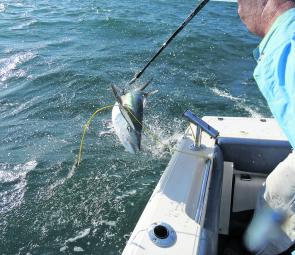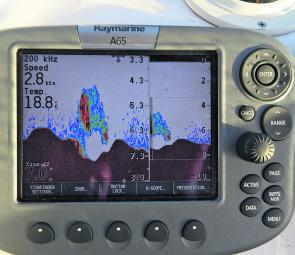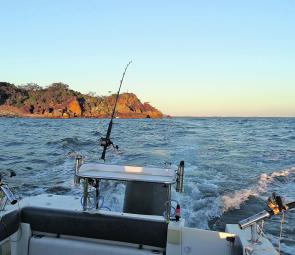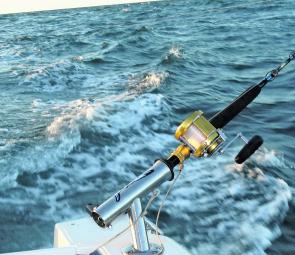Most of my life I’ve been into mackerel fishing of some sort or another. Much of my youth was spent high-speed spinning chrome lures for them in the bays of South East Queensland. Schoolies, spotties, a few greys and the occasional Spaniard provided plenty of fun to a kid who loved catching and eating them.
Alas those big schools of my youth are pretty much no longer in SE QLD. I blame the government operatives who were far too late in bringing in the regulations to control commercial mackerel netting.
Some commentators are of the opinion that mackerel will avoid areas where they have been heavily netted in the past. My take on this is that the genetic coding that made those fish prefer to school up in open bays has been killed off, thus the genetic coding for other areas have come to the fore.
One area where it is hard for the nets to get to, are the waters around the rocky headlands. These spots are worth targeting and will still produce a fish or two per session (a caveat: some rocky headlands are now Green Zones). Not all of the rocky headlands are accessible to small trailer craft in the 4.3m length range, but some are, especially when the weather is fine. Often craft can be launched from nearby beaches or rivers with tame bars to negotiate.
These days most crews go offshore in slightly larger boats than we did when I was a youngster. In those days a trailer boat up to about 18’ was the limit of your Falcon/Commodore tow package, 15’ boats were common offshore. These days with family 4WDs being almost the norm for fishing families, 24’ is comfortable and legal.
Once upon a time the headland scene was the domain of 14’ and 15’ boats. Nowadays you are just as likely to see a very big half-cab in close to the rocks with a spread of lures out. Also the closure of the offshore rock outcrops to turn them into dive locations has forced the bigger boats that would normally go to them, to have to focus on the remaining headlands that aren’t Green Zones; instead of finding ‘your own’ headland for the day’s fishing like you used to. These days it can be a turn up and join the queue scenario and politeness becomes a factor in your day’s enjoyment. I wonder if those advocating the closures really understood the second order knock on effects of increasing pressure on the remaining spots.
If my genetic coding theories are correct, then focusing fishing pressure on limited spots is the worst thing that can be done to the mackerel’s survival. Better to spread out the impact so that each spot continues to produce fish for its own future.
These waters are best targeted by trolling as the fish aren’t often schooled up as thickly as they once were. Trolling covers ground and allows you to present a variety of lures to the fish at the same time. Small boats are manoeuvrable and can get their troll patterns where big boats fear to tread. No matter how you catch them, small macks are always fun and they still taste great when filleted and cooked fresh on the grill.
I troll for them by towing a spread of at least three lures. Because the nature of headland trolling requires you to be able to keep the boat on the go and away from the rocks once you hook a fish – then typically more than two lures per person to wind in (one of you will be on the rod fighting the mackerel) becomes a problem. Accordingly, a two-person crew could run a three lure pattern and a three-person team may run a four lure pattern.
The ideal trolling speed is the 6-6.5 knot range, but don’t be too rigid. If the fish are not biting then be sure to slow it down a little or even to speed it up. Use your GPS to measure your boat speed; the paddle-wheel type speedo is notoriously inaccurate.
When slowing down, (because of the sea conditions) consider running a spoon in your pattern. When speeding it up try to include a lead-headed feather.
A typical 6-6.5 knot pattern could include – a 1oz Magnum Rat-L-Trap bibless, a small Rapala X-Rap and a larger Rapala CD or Halco Laser Pro. The occasional small mackerel will still eat a big offering. Meanwhile the big offering is targeting the Spanish mackerel that haunt the same headlands as their smaller cousins. In fact, don’t be surprised if you find that a small mackerel makes a welcome meal for a big Spaniard.
The best time of day for targeting the full range of mackerel species is referred to by some as ‘grey’ light, i.e. that time at dusk and dawn between when the sun is shining and darkness.
The turn of the tide can also have an influence. A turning tide that coincides with a grey sky is probably the best date on the calendar to circle. Either side of high or low tide will work at some spots or depending on the location’s other influences. Sometimes it is the low flow times that produce the fish, other times it is very much a case of ‘no run, no fun’.
However, a lot still depend on the location, or more correctly the locations within the location. Spots such as at headlands adjacent to river mouths on the run-out tide can be the most productive time when the baitfish (and/or their feed) are flushed out of the estuary and hang out at the headland until the next run-in tide.
As a side note, please give consideration to anglers fishing off the rocks. They need casting room, and if they are throwing metal for mackerel then that casting distance can be close to 100m, more in some cases. Additionally they need room to fight their fish.
Mackerel are clean fighters and these days with light line-class mackerel fishing being less important to the wider fishing community; most mackerel come to the boat pretty fresh after their first long run. Therefore, things can get a little tricky at the side of the boat. I run 30lb or 50lb line on my reels just so that I’m able to negotiate on my terms when a big mackerel latches on while I’m targeting small macks.
Once the torpedo-like mackerel is beside your vessel at the end of the fight, keep your engine in gear and idle the boat forward so that water pressure and heavier line steers (or pulls) the mack along to make gaffing easier.
Speaking of landing fish, gaffing mackerel is a skill to be practised. I like long gaffs and diamond-shaped heads for Spaniards and small round heads for spotties and schoolies. I reckon most mackerel losses at the gaff are due to anglers using those short handles, 1.5m length, that fit in their boat’s side pockets. Depending on your gaffing technique, proper mackerel (and yellowfin tuna) gaffs start at 2m. I used 2.4m model when I was a kid and now I use 3.6m gaffs in the boat. With the small gaffs it is very hard to reach out and over the fish while it is still side on to the boat and under the water.
Queensland mackerel regulations:
SpeciesMin. lengthBag Limit
| Grey | 60cm | 5 |
|---|---|---|
| Spanish | 75cm | 3 |
| School | 50cm | 10 |
| Shark | 50cm | 10 |
| Spotted | 60cm | 5 |
1
This Spaniard action shot, shows a good view of the lure and also the gaff-point angles of the gaff.
2
This image shows a submerged bait school that was being trolled around to catch the mackerel. Take note of the humps in the bottom (bommies) and the water depth. This also shows the advantage of a spilt screen zoom.
3
A three rod trolling spread using elevation and T-holders to get the perfect type of rod tip separation, which reduces tangles and creates the opportunity for manoeuvrability and tight turns. This is a good distance to troll out from headlands.
4
This school mackerel was caught on a Laser Pro. Small macks will eat big lures but are better targeted with mack snacks (i.e. smaller scaled down versions of the big lures).
5
We upgraded this Penn specifically for mackerel trolling. The Reelax removable T-holder drops into a normal rod holder to improve your trolling spread, provides a good angle for pulling bibbed lures and is easy to use. Note the safety line attached under the reel clamp.
Reads: 1989








